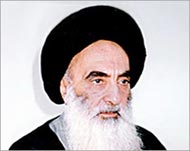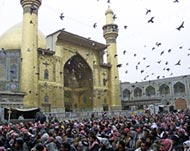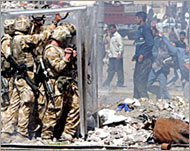The Shia factor: Key to Iraq’s future?
When Grand Ayat Allah al-Sistani, Iraq’s most influential Shia leader, demanded direct elections he offered a glimpse of his power: 30,000 Shia promptly took to the streets of Basra.

Their brethren in Baghdad held demonstrations for three consecutive days.
Iraq’s Shia population is flexing its new-found political muscle for the first time after decades of being silenced not only by Saddam Hussein, but successive governments beginning in 1921.
Spearheading the effort is al-Sistani, an Iranian-born cleric. He has so far ordered the Shia to cooperate with occupation forces and not launch resistance attacks.
After issuing veiled warnings to occupation authorities that his community would not be as cooperative if his demands were not met, Washington pleaded for the United Nations to intervene. The world body obliged and sent a fact-finding mission to Iraq.
The UN, which pulled out of Iraq after a devastating attack against its Baghdad headquarters in August left 23 employees dead, declared Iraq was not ready for direct elections.
Al-Sistani backed down from holding direct elections this year. This is just one example of the Shia sway with occupation authorities.
The heavyweight cleric refuses to meet American occupation authorities directly, but appoints mediators to get his demands across.
|
“They basically say that they are trying to maintain an upper hand and they claim that’s because of their higher numbers” Dr Paul Salem, |
“There is no dialogue whatsoever between him and the Americans,” says Supreme Council for Islamic Resistance in Iraq (SCIRI) spokesman Dr Hamad al-Bayati.
SCIRI was based in Iran until the fall of Saddam and is one of the largest Shia political parties. The group quickly aligned itself with al-Sistani in the aftermath of the war, thus garnering the support of the cleric’s followers.
Shia demands
Al-Bayati ticks off the gains the Shia have made with the occupation authorities over the past year.
“The Americans wanted to appoint a military commander after the war. We refused. Gradually, they gave up the idea. They wanted to appoint a consultative council and we refused. They gave up this idea,” he says. “A lot of things have been achieved, I can’t count them all.”
A total of 13 out of 25 members of the US-appointed Iraqi Governing Council are Shia, a number al-Bayati says does not reflect their percentage in the country’s diverse ethnic and cultural make-up.
The Shia say they constitute 60% of Iraq’s population, but there is no consensus on this and some say the number is lower.
 |
|
Al-Sistani is highly influential |
However, al-Bayati says occupation forces have a long way to go before meeting all of the Shia’s aspirations.
“They are lacking. They are still trying to part the Shia from their rights,” he says, referring to US occupation authorities.
“They allow the Peshmerga (the Kurdish militia) to operate … but they prevent all the Shia militias from operating in Iraq and we think we should enjoy the same rights.”
The Peshmerga, based in the autonomous Kurdish region of northern Iraq, were placed under US command in the run-up to the war and fought alongside occupation troops.
“That’s not an excuse to discriminate against certain communities of Iraqi people,” protests al-Bayati.
Meddling clerics
The Shia are also demanding special status granted to all religious leaders in the country “just like the Pope in the Vatican”, he says.
But many Iraqis want to ensure state and religion remain separate.
“The Shia should distinguish religion from politics and they should stop meddling in politics,” says political science professor Dr Abd Al-Sattar Jawad of Baghdad University.
And the apparent honeymoon period between the US occupation authorities and Shia is coming to an end, he says.
“When civil administrator [Paul] Bremer is going to expand the Governing Council and to establish the new parliament in Iraq, he will draw new lines and he’s going to contact more parties, groups and even tribes in the Sunni triangle,” says Jawad.
He was referring to the towns of Ramadi, Falluja and Baquba, hotbeds of anti-occupation attacks.
Influence
The Shia community’s influence in post-Saddam Iraq is “over-whelming”, says Beirut-based Middle East political analyst and writer Dr Paul Salem.
 |
|
Mosques have become a forum |
“In all the different scenarios, they are playing – and will play -a leading role,” he says.
“They basically say that they are trying to maintain an upper hand and they claim that’s because of their higher numbers,” he adds.
Their influence comes from their strength in numbers, refraining from direct war against the occupation and backing from Iran, which is trying to wield its influence in Baghdad, says Salem.
“The main Shia group, the Revolutionary Council, was based in Iran and was funded and directed (by Iran),” he says, adding that Tehran as a regional heavyweight might continue to sway its authority in Baghdad.
“America might leave one day and Iran will always be very close,” he points out.
“The Shia … have made the decision to be cooperative or passive, essentially figuring that they are the ones to inherit Iraq once the Americans’ direct occupation reduces,” says Salem.
Washington was not prepared for the upsurge of Shia clerical power in post-Saddam Iraq, he adds. In the absence of secular political parties, there has been a rise of religious politics.
“Once they got rid of him, many were surprised by the results: that they were not welcome; that there was no plan for post-war Iraq; that it’s a big mess and that, if anything, Islamic Shia leaders are going to be a dominant force, something that was certainly not part of the original plan.”
Regional fears
A rise of Iraq’s Shia will be felt by the entire Middle East – particularly states with their own Shia populations – and Baghdad’s neighbours, which include Syria, Saudi Arabia, Iran, Kuwait, Jordan and Turkey.
 |
|
Shia have largely cooperated with |
“What they fear is the rise of the Shia power in Iraq in general,” says Salem. “Iran is now dominant inside Iraq. Regardless of future relations with the United States, that is a very serious development for many counties in the region, particularly the Sunni countries.”
Iran’s 1979 Islamic revolution was not only a shock to the West, but to the Middle East.
“Any close relation with the Iranian clergy will pose a danger to Iraqi security and this is quite understandable by the American administration. They would not like to see the Iranian model sweeping the region,” he says.
However, “the Iranian model of Shiaism as a whole is not accepted by most Iraqis,” says Jawad.
And the region is now more concerned with maintaining stability in war-torn Iraq, says Lebanon-based political Islam expert Dr Ridwan al-Sayyid.
“Initially, the Sunnis in other states were angered and frightened by the rise of the Shia in Iraq. But now they are concerned about strengthening Iraqi unity … so it remains an independent and united state in the face of Iranian influence,” he says.
“It’s up to the leaders in Iraq, Shia included, to see which direction they will move from here,” says Salem.